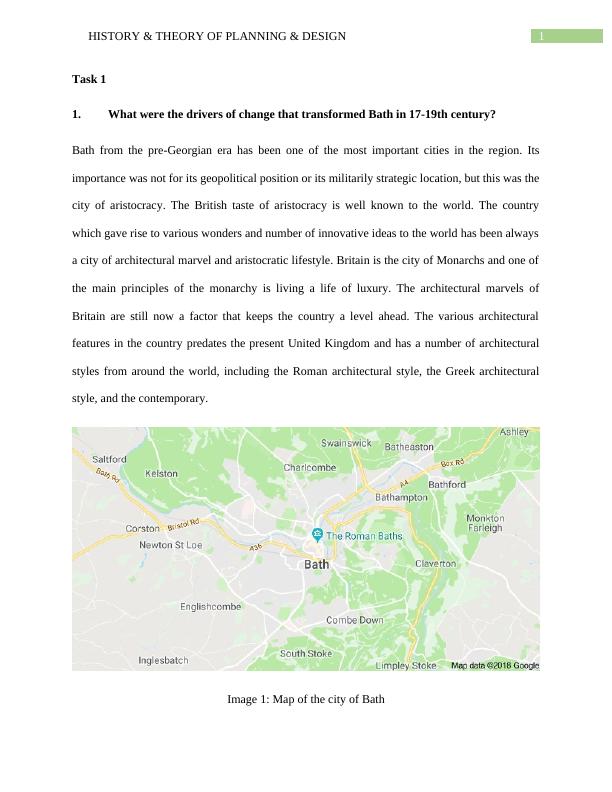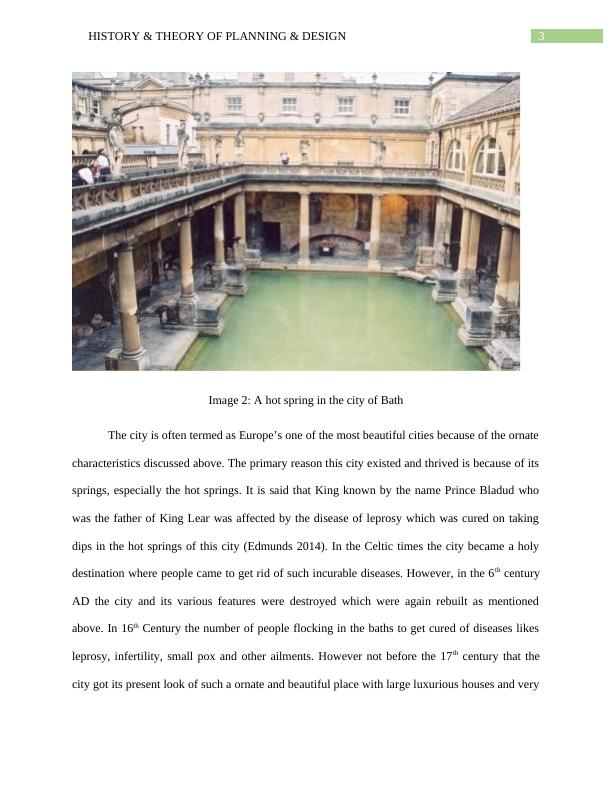History & Theory of Planning & Design
Added on 2023-06-13
16 Pages3644 Words334 Views
Running head: HISTORY & THEORY OF PLANNING & DESIGN
HISTORY & THEORY OF PLANNING & DESIGN
Name of the Student
Name of the University
Author note:
HISTORY & THEORY OF PLANNING & DESIGN
Name of the Student
Name of the University
Author note:

1HISTORY & THEORY OF PLANNING & DESIGN
Task 1
1. What were the drivers of change that transformed Bath in 17-19th century?
Bath from the pre-Georgian era has been one of the most important cities in the region. Its
importance was not for its geopolitical position or its militarily strategic location, but this was the
city of aristocracy. The British taste of aristocracy is well known to the world. The country
which gave rise to various wonders and number of innovative ideas to the world has been always
a city of architectural marvel and aristocratic lifestyle. Britain is the city of Monarchs and one of
the main principles of the monarchy is living a life of luxury. The architectural marvels of
Britain are still now a factor that keeps the country a level ahead. The various architectural
features in the country predates the present United Kingdom and has a number of architectural
styles from around the world, including the Roman architectural style, the Greek architectural
style, and the contemporary.
Image 1: Map of the city of Bath
Task 1
1. What were the drivers of change that transformed Bath in 17-19th century?
Bath from the pre-Georgian era has been one of the most important cities in the region. Its
importance was not for its geopolitical position or its militarily strategic location, but this was the
city of aristocracy. The British taste of aristocracy is well known to the world. The country
which gave rise to various wonders and number of innovative ideas to the world has been always
a city of architectural marvel and aristocratic lifestyle. Britain is the city of Monarchs and one of
the main principles of the monarchy is living a life of luxury. The architectural marvels of
Britain are still now a factor that keeps the country a level ahead. The various architectural
features in the country predates the present United Kingdom and has a number of architectural
styles from around the world, including the Roman architectural style, the Greek architectural
style, and the contemporary.
Image 1: Map of the city of Bath

2HISTORY & THEORY OF PLANNING & DESIGN
The city of Bath is by feature quite similar to the name given to it. The city is famous for
the large Roman baths. Presently the city can be defined as an international “Spa”. In the 60 C
the city was named as Aquae Sulis which means “water of the Sulis”, and was one of the centers
where people from all over Europe came to enjoy the Hot water bath in the Hot springs (Rogers
2014). In the 7th Century “Bath Abbey” was founded which had religious values to it. In the 12th
Century this same bath was again rebuilt which have been greatly affected due to the influence of
time. Again such rebuilding effort took place in the 16th Century. In the 17th Century there were
claims about the medicinal properties in the Bath which made this one of the very famous and
sought after tourist destinations in the region (Neale 2014). In the Georgian era similar trends
were seen when the Bath water taken for its medicinal property and people from all over the
region came for getting rid of various diseases (Haraldsson 2014). The Georgian style of
architecture is very royal and has various spectacular features like precious and semi-precious
stones and very intricate designs.
The city of Bath is by feature quite similar to the name given to it. The city is famous for
the large Roman baths. Presently the city can be defined as an international “Spa”. In the 60 C
the city was named as Aquae Sulis which means “water of the Sulis”, and was one of the centers
where people from all over Europe came to enjoy the Hot water bath in the Hot springs (Rogers
2014). In the 7th Century “Bath Abbey” was founded which had religious values to it. In the 12th
Century this same bath was again rebuilt which have been greatly affected due to the influence of
time. Again such rebuilding effort took place in the 16th Century. In the 17th Century there were
claims about the medicinal properties in the Bath which made this one of the very famous and
sought after tourist destinations in the region (Neale 2014). In the Georgian era similar trends
were seen when the Bath water taken for its medicinal property and people from all over the
region came for getting rid of various diseases (Haraldsson 2014). The Georgian style of
architecture is very royal and has various spectacular features like precious and semi-precious
stones and very intricate designs.

3HISTORY & THEORY OF PLANNING & DESIGN
Image 2: A hot spring in the city of Bath
The city is often termed as Europe’s one of the most beautiful cities because of the ornate
characteristics discussed above. The primary reason this city existed and thrived is because of its
springs, especially the hot springs. It is said that King known by the name Prince Bladud who
was the father of King Lear was affected by the disease of leprosy which was cured on taking
dips in the hot springs of this city (Edmunds 2014). In the Celtic times the city became a holy
destination where people came to get rid of such incurable diseases. However, in the 6th century
AD the city and its various features were destroyed which were again rebuilt as mentioned
above. In 16th Century the number of people flocking in the baths to get cured of diseases likes
leprosy, infertility, small pox and other ailments. However not before the 17th century that the
city got its present look of such a ornate and beautiful place with large luxurious houses and very
Image 2: A hot spring in the city of Bath
The city is often termed as Europe’s one of the most beautiful cities because of the ornate
characteristics discussed above. The primary reason this city existed and thrived is because of its
springs, especially the hot springs. It is said that King known by the name Prince Bladud who
was the father of King Lear was affected by the disease of leprosy which was cured on taking
dips in the hot springs of this city (Edmunds 2014). In the Celtic times the city became a holy
destination where people came to get rid of such incurable diseases. However, in the 6th century
AD the city and its various features were destroyed which were again rebuilt as mentioned
above. In 16th Century the number of people flocking in the baths to get cured of diseases likes
leprosy, infertility, small pox and other ailments. However not before the 17th century that the
city got its present look of such a ornate and beautiful place with large luxurious houses and very

End of preview
Want to access all the pages? Upload your documents or become a member.
